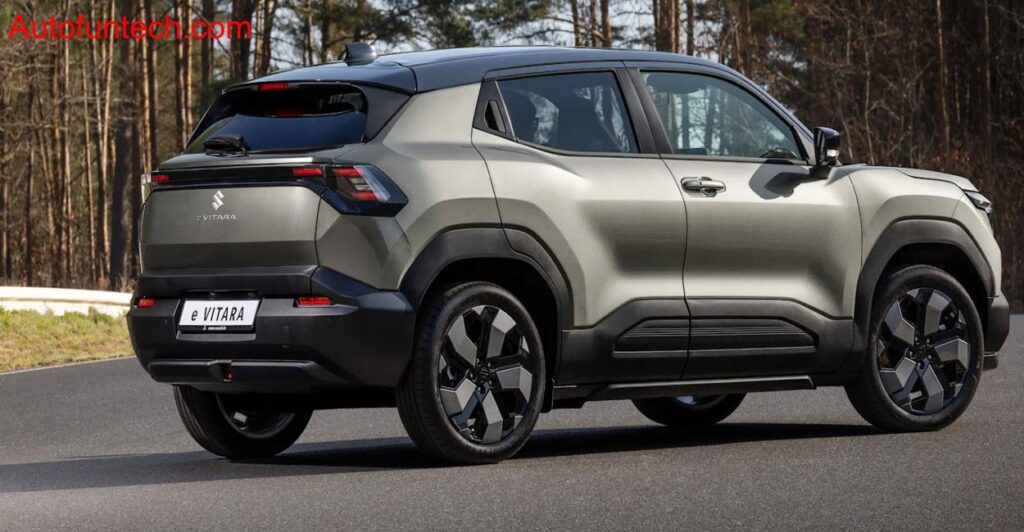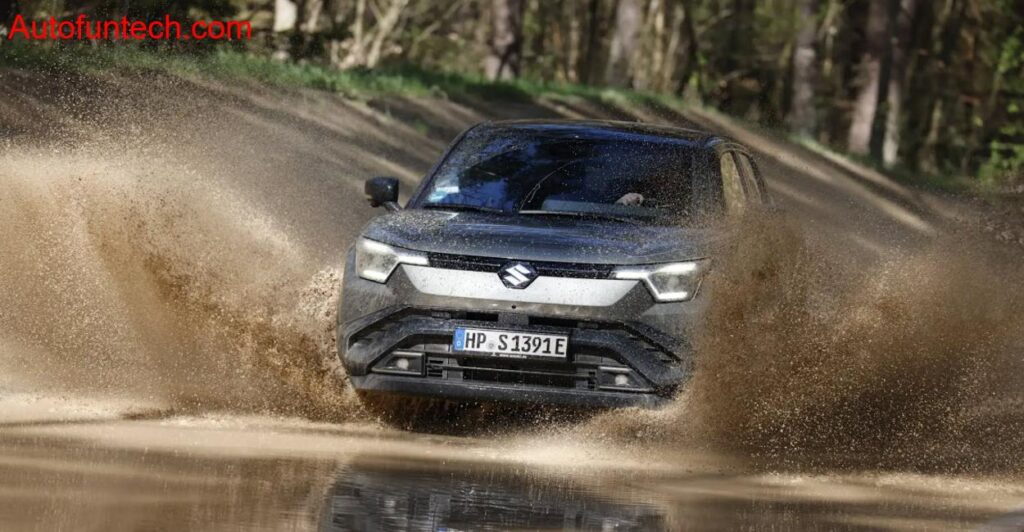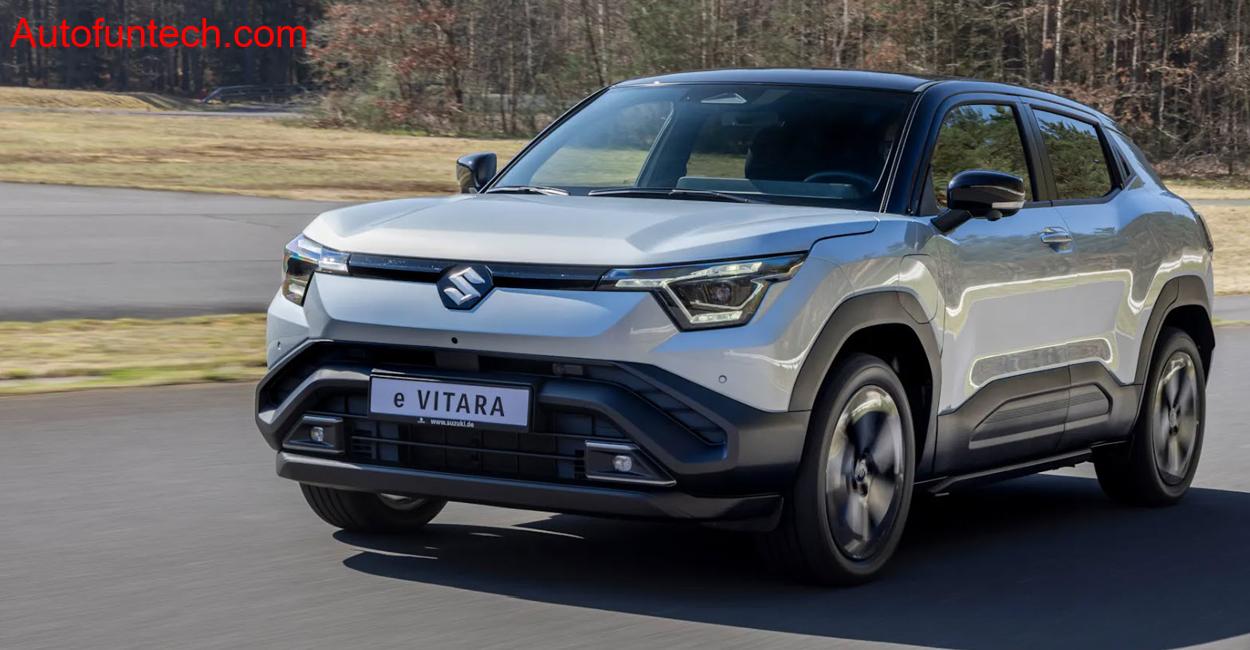
A New Face for a Familiar Name
Standing in front of the e-Vitara, it was immediately clear that Suzuki hadn’t just slapped an “e” on the badge and called it a day. This was something altogether fresh. The front fascia wears sharp, narrowed LED eyes , almost like the car’s peering into the future. The upright stance and wide haunches give it a compact yet muscular demeanor, much more assertive than the outgoing petrol Vitara.
From the side, the black C-pillar blends into the tinted rear windows, floating the roof visually, while bold cladding hugs the lower doors. The rear? A full-width light bar demands your attention at night, mirroring the front’s modern minimalism.
But the e-Vitara’s charm is more than skin-deep. It’s built on a new lightweight EV-specific platform developed in collaboration with Toyota. And believe me, that foundation shows its worth on Kofel’s wild twists.
Inside the Cabin: Simplicity with a Hint of Flash
Sliding into the cabin, I was welcomed by a blend of digital flair and honest simplicity. The 10.25-inch digital instrument cluster glowed to life behind the flat-bottomed steering wheel, giving me everything I needed , range, regen level, speed , in crisp resolution. The 10.1-inch infotainment screen at the center was responsive, and while not revolutionary, it offered wireless Android Auto which worked flawlessly with my Pixel.
Physical buttons for the climate control were a relief, especially when I needed quick access in the cold mountain air. The only letdown? Some plastics on the dash and doors felt flimsy and hollow to the touch. But again, this is Suzuki , function often comes before finesse.
The rear seats slide by up to 16 cm, and I tested that firsthand when we had to make space for a gear duffle and a foldable mountain bike. Rear legroom was unexpectedly generous for this size of SUV. I’d estimate boot space to be just around 300 liters with the seats in play , not massive, but modular enough for a weekend trip into the hills.
Electric Heart, Alpine Soul: How It Drives
Now comes the soul of it. We tested the 135 kW (184 hp) all-wheel drive variant, the top dog in the e-Vitara pack. With a 0–100 km/h sprint in just under 8 seconds and a governed top speed of 150 km/h, it’s not a performance SUV, but it doesn’t try to be. What it is, however, is confidence incarnate.
On the ascent to Kofel, the second electric motor on the rear axle kicked in smoothly as we transitioned from asphalt to loose gravel. That instant torque typical of EVs meant no wheelspin, no hesitation , just grip. The 48 kW rear motor may not sound like much on paper, but combined with the front motor’s 135 horses, it gave the e-Vitara an almost rally-esque eagerness in “Sport” mode.
Switching between Eco, Normal, and Sport modes was mostly about throttle response and regen levels. Eco dulled everything, best used only when coasting downhill. Normal was my go-to for Kofel’s switchbacks, offering balanced response and moderate regen that helped simulate engine braking on declines. Sport tightened things up just enough to have fun without being twitchy.

Technical Specifications of the Suzuki e-Vitara
| Specification | Detail |
| Powertrain | Dual Motor (AWD) or Single Motor (FWD) |
| Power Output (FWD) | 128 kW (174 hp) |
| Power Output (AWD) | 135 kW (184 hp) |
| Battery Options | 49 kWh and 61 kWh LFP Batteries (BYD-sourced) |
| Range (WLTP) | 345 km (small battery), 430 km (large battery FWD), 400 km (AWD) |
| Charging (AC) | 11 kW |
| Charging (DC Fast Charge) | Up to 150 kW (large battery only) |
| 0-100 km/h (AWD variant) | ~8.0 seconds |
| Top Speed | 150 km/h (limited) |
| Vehicle Length | 4.28 meters |
| Curb Weight | Approx. 1.7 tons |
| Infotainment Display | 10.1 inches |
| Instrument Cluster | 10.25 inches |
| Warranty | 8 years (battery), 3 years (vehicle) |
Living with the e-Vitara in the Wild
After the climb, we spent the night at a rustic cabin near the foot of Kofel. Temperatures dipped close to freezing, and here’s where the heat pump system in the e-Vitara showed its smarts. The cabin stayed warm without nuking battery levels. With seat and steering wheel heaters on, I barely noticed the cold.
We ran the car down winding roads the next morning. With a half-charge left and no fast chargers nearby, I had to manage regen and throttle carefully. On descents, the brake regen system regained a good 4–5% battery over 12 kilometers , impressive for such a compact SUV. The range estimate remained surprisingly accurate throughout.
Visibility was decent, though rearward sightlines were hindered by the bulky C-pillars. Thankfully, the 360-degree camera and sensors were reliable. Apple CarPlay mirrored my navigation app clearly, and the eight-speaker sound system in the Comfort+ trim filled the cabin with crisp acoustic warmth.
Price, Equipment, and Where It Stands
The expected base price is around €31,000, with higher trims stretching closer to €38,000. Not cheap for a Suzuki, but not outrageous in the current EV landscape. It’s competitively placed against the likes of the MG ZS EV, Hyundai Kona Electric, and its own twin , the Toyota Urban Cruiser.
Trim levels are simple: Club with the smaller battery and decent kit, Comfort with the larger battery and extras, and Comfort+ that gives you almost everything , panoramic glass roof, wireless charger, better audio, power seats.
Warranty is industry average, but the overall package? Solid, straightforward, and usable.
Conclusion: Suzuki’s Electric Flagbearer Gets It Right
Up there in Kofel, away from the city grid and polished press roads, the Suzuki e-Vitara proved itself not just as a capable electric SUV, but as a car with heart. It doesn’t try to be revolutionary. It’s not here to dethrone Teslas or outshine Hyundai’s e-GMP stars. What it does, though, is bring Suzuki’s honest, no-frills ethos into the EV era.
Would I buy one? If I needed a reliable urban commuter that could hold its own on the occasional trail, yes. If I valued mechanical simplicity backed by Toyota engineering and Suzuki’s durability, then absolutely.
This is not a car built to impress , it’s a car built to endure.


Leave a Comment